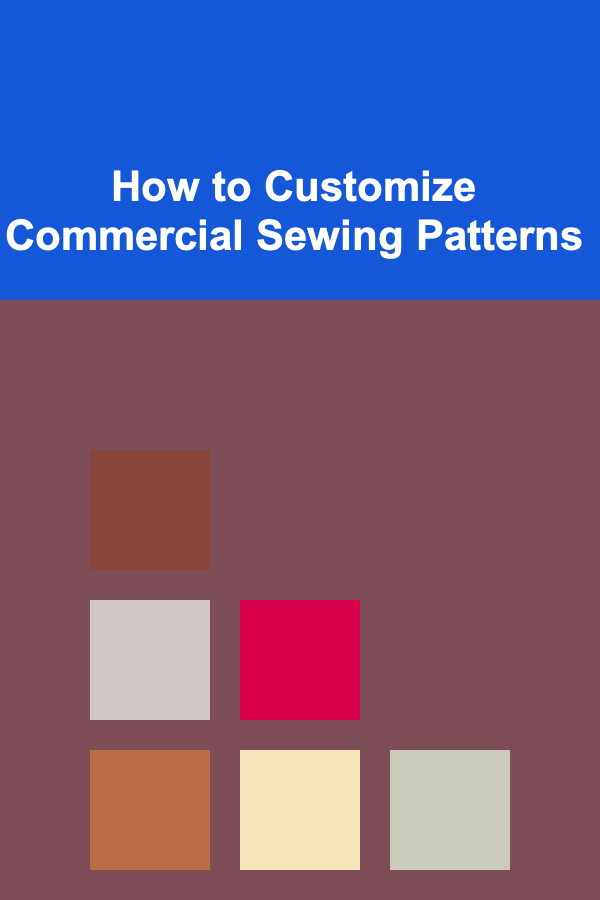
How to Customize Commercial Sewing Patterns
ebook include PDF & Audio bundle (Micro Guide)
$12.99$11.99
Limited Time Offer! Order within the next:

Sewing your own clothes is a rewarding and creative way to build a personalized wardrobe. One of the easiest ways to get started is by using commercial sewing patterns. These patterns are widely available in fabric stores and online, offering a wide variety of designs, styles, and sizes. However, the beauty of sewing lies in its ability to be customized to suit your specific measurements, taste, and style. Customizing commercial sewing patterns allows you to create garments that are truly one-of-a-kind, ensuring a perfect fit, enhanced comfort, and a look that is uniquely yours.
This article will provide a comprehensive guide on how to customize commercial sewing patterns. Whether you are new to sewing or an experienced sewer looking to refine your craft, this guide will walk you through the process of modifying commercial patterns to achieve the best results. From altering fit to adding personal touches, this guide covers all the essential steps to ensure your finished garments are flattering and functional.
Step 1: Understand the Basics of Commercial Sewing Patterns
Before you begin customizing any pattern, it is essential to have a solid understanding of what a commercial sewing pattern is and how it works. Most commercial patterns come with a printed design on large sheets of tissue or paper, along with instructions on how to cut, sew, and assemble the pieces. These patterns typically include multiple sizes, and the markings on the pattern indicate where to cut, stitch, and fold.
When selecting a pattern, it is essential to consider your body type, measurements, and the type of fabric you plan to use. Patterns often include a size chart, which correlates body measurements with pattern sizes. However, commercial patterns are often designed for a generic, "standard" fit, which may not always suit your exact shape. Customizing a pattern ensures that you can adjust it to your specific needs and preferences.
Key Elements to Look for in a Commercial Pattern:
- Pattern pieces: These are the templates for cutting fabric, typically labeled with names like front, back, sleeve, and collar.
- Grainlines: These lines indicate how the fabric should be aligned to ensure that the fabric stretches or drapes correctly.
- Seam allowances: This is the extra fabric margin included in the pattern to allow for stitching the pieces together.
- Notches: These are small marks on the pattern that help align different pieces of the garment during assembly.
- Fit guides: Commercial patterns often include guidance on how to fit the garment to different body shapes.
Once you familiarize yourself with these components, you can begin the process of customizing the pattern to fit your unique style and body shape.
Step 2: Take Accurate Measurements
Accurate measurements are crucial when it comes to customizing commercial sewing patterns. Taking your measurements ensures that the pattern will fit your body properly, allowing for adjustments and alterations to create the perfect fit.
Key Measurements to Take:
- Bust: Measure around the fullest part of your bust while keeping the tape comfortably snug.
- Waist: Measure around the smallest part of your waist, typically just above the belly button.
- Hip: Measure around the fullest part of your hips, making sure the tape is parallel to the floor.
- Back waist length: Measure from the nape of your neck to your natural waistline to determine the length of your top or dress.
- Inseam: For pants, measure from the top of the inner thigh to the ankle bone.
- Sleeve length: Measure from the shoulder seam to the wrist or desired sleeve length.
It is also important to consider other measurements like neck circumference, shoulder width, and the length of specific garment pieces, depending on the pattern. Make sure to write down all of your measurements and compare them to the size chart included in the pattern.
Tip:
When taking measurements, wear close-fitting clothing or undergarments and keep the measuring tape parallel to the floor. Take measurements in a relaxed posture, not while slouching or tensing your body.
Step 3: Choose the Right Fabric
Fabric choice plays a significant role in how a garment fits and drapes. Different fabrics have various properties, such as stretch, weight, and texture, which can affect how a pattern fits. For instance, a pattern designed for a lightweight cotton may not work well with a heavy wool fabric.
Tips for Choosing Fabric:
- Fabric weight: Consider the weight of the fabric and how it will impact the structure of the garment. For example, heavier fabrics such as denim may require a pattern designed for structure, while lighter fabrics like silk are better suited for flowing designs.
- Fabric stretch: If the fabric has stretch (such as jersey or spandex), you may need to adjust the pattern for ease and comfort.
- Fabric drape: Fabrics like rayon and chiffon have a lot of drape and may require more precise cutting and adjustments to maintain their flowy look.
Many commercial patterns will specify what type of fabric is suitable for that design, but don't be afraid to experiment with different fabrics to create a more personalized look. Just keep in mind that you may need to make additional adjustments to the pattern depending on the fabric's behavior.
Step 4: Make Pattern Adjustments for Fit
Even though commercial patterns are graded to fit a range of sizes, they may not always fit you perfectly right out of the envelope. Customizing the fit is one of the most important aspects of pattern modification. Fortunately, there are a variety of techniques you can use to alter a pattern to match your measurements.
Common Fit Adjustments:
-
Length adjustments: If a garment is too long or too short for your body, you can adjust the length of the pattern pieces. This can be done at the hem, waist, or bustline, depending on where the issue lies.
- Shortening/lengthening the body: If the pattern is too long, cut the pattern along the designated lines and overlap or extend it to achieve the correct length.
- Shortening/lengthening the sleeves: Similar to body length adjustments, sleeve length can be altered by cutting along the sleeve's lengthening/shortening lines and adjusting as needed.
-
Bust adjustments: If the bust area is too tight or too loose, you can add or remove darts or princess seams to improve the fit.
- Full bust adjustment (FBA): This technique is used when there is a need to add extra room to the bust area. It involves slashing the pattern at specific points and spreading the pattern pieces to create more space in the bust.
- Small bust adjustment (SBA): This is the opposite of an FBA and involves removing excess fabric from the bust area.
-
Waist and hip adjustments: If the waist and hip areas do not align with your measurements, you can make alterations by adding or reducing fabric in these areas.
- Taking in or letting out seams: The easiest way to adjust the fit is by taking in or letting out seams along the side seams, back darts, or princess seams.
-
Shaping the garment: You can add waist darts, pleats, or tucks to further shape the garment to fit your body.
Tip:
Before making any adjustments to the pattern itself, consider making a mock-up (also known as a muslin) of your garment. This allows you to test the fit and make any necessary changes before cutting into your final fabric.
Step 5: Add Personal Touches
Once you have made all necessary adjustments for fit, the next step is to add your own personal touches to the garment. Customizing a commercial pattern is not just about achieving a good fit but also about adding details that reflect your style.
Ideas for Personalization:
- Necklines: You can adjust the neckline of a garment to create a deeper V, a higher scoop, or a more dramatic shape. Use the existing pattern as a base and experiment with different shapes.
- Sleeve modifications: Add or remove sleeves, change their length, or experiment with different sleeve styles such as puffed, bell, or cap sleeves.
- Embroidery and embellishments: Add unique details like embroidery, lace, beads, or appliqué to make the garment truly one-of-a-kind.
- Pockets: Add pockets in strategic places, whether they be hidden inside the garment or as a design feature.
- Hems and finishes: You can change the type of hem (such as a rolled hem, facing, or bias tape) to add a finishing touch that suits your style.
Tip:
Consider drawing out any changes on paper or in a sketchbook before cutting your fabric to visualize the changes and ensure they complement the overall design.
Step 6: Sew and Assemble the Garment
After making the necessary pattern adjustments and personalizations, it's time to sew the garment. Follow the pattern instructions closely, making sure to transfer all markings, notches, and stitching lines onto your fabric. Remember, sewing is a process that requires patience, so take your time with each step.
Use a combination of pins, basting stitches, and pressing to ensure accurate seams. If you're working with delicate fabrics or intricate designs, make sure to finish the raw edges to prevent fraying.
Conclusion
Customizing commercial sewing patterns allows you to transform a basic design into a garment that fits you perfectly and expresses your unique sense of style. From taking accurate measurements to making fit adjustments, adding personal touches, and carefully assembling your garment, the process of customization will not only result in better-fitting clothes but also in a deeper connection to the art of sewing. By mastering these techniques, you'll be able to create wardrobe staples that reflect your personal tastes and meet your specific needs, ensuring a sewing experience that's both creative and fulfilling.
Reading More From Our Other Websites
- [Horseback Riding Tip 101] From the Stable to the Arena: A Beginner's Guide to Equestrian Terminology
- [Home Budget Decorating 101] How to Create a Beautiful Home with Discount Furniture
- [Organization Tip 101] How to Organize Your Exercise Equipment at Home
- [Gardening 101] Creative Ideas for Designing Your Perfect Herb Garden
- [Home Holiday Decoration 101] How to Style Your Holiday Tree Like a Professional Designer
- [Home Budget 101] How to Save Money on Home Renovations by Doing It Yourself
- [Trail Running Tip 101] How to Train for Variable Surface Changes: From Soil to Rock
- [Personal Financial Planning 101] How to Use Budgeting Tips for Beginners to Save for a Down Payment on Your First Home
- [Personal Care Tips 101] How to Use Lip Balm to Protect Your Lips from Pollutants
- [Screen Printing Tip 101] Eco-Friendly Ink & Materials: Sustainable Screen-Printing Techniques

How to Make Money Online as an Influencer Outreach Specialist: 10 Actionable Ideas
Read More
Using a One-Page Website to Build a Strong Online Presence
Read More
How To Understand 3D Printing in Prosthetics
Read More
How to Provide Safe Chews for Dental Health
Read More
How To Play Narrative-Driven Indie Games
Read More
How to Develop a Personal Brand as a Corporate Communications Director
Read MoreOther Products

How to Make Money Online as an Influencer Outreach Specialist: 10 Actionable Ideas
Read More
Using a One-Page Website to Build a Strong Online Presence
Read More
How To Understand 3D Printing in Prosthetics
Read More
How to Provide Safe Chews for Dental Health
Read More
How To Play Narrative-Driven Indie Games
Read More